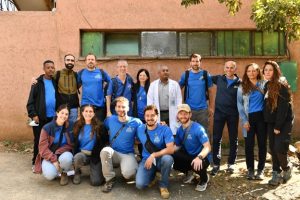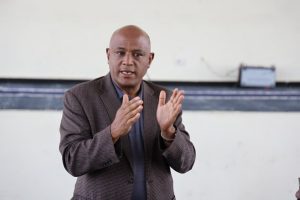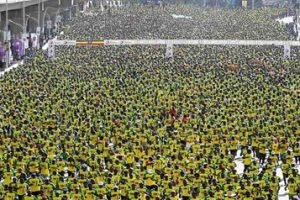
Seen in light of Ethiopia’s available water resources and potential,its resources are still very little exploited.
Surface and underground waters can be used both for hydropower generation and irrigation.
To translate the nation’sambitious development plan into action, aside from the ongoing endeavor, more energy firms including the private ones should get involved in exploiting the multifaceted energy sources particularly the renewable ones such as wind, solar and geothermal energy.
During the last two decades, the government had been aggressively engaged in constructing various hydro power dams.To that end,it had allocated local and foreign financial, technical and human capitals.
Constructing dams and engaging in power generation business are expensive and capital intensive ventures. Hence, utilizing dams cost effectively as per their life span is vital therefore, periodical maintenance is needed.
Side by side with these,properly managing the catchment areas through conservation work to reduce silt accumulation, which affects the duration of dams, is decisive. Removing sediments from dams needs high tech. It also entails a high financial cost. Hence,as a precautionary measure,doing environmental protection workis economically feasible.
In this regard, the nation past performance is not satisfactory.
The Borkena river dam constructed for irrigation purpose by the previous regime located in the southern Wollo in Amhara state is the case in point.
The clearance of vegetation covers both for expansion of farming plots and for household energy had turned the river basin into barren land.
During the rainy season,floods from the mountainous areas washed away top soil which unabatedly entered into the river.
As a result,the cumulative effect of these dimentation the dam has screeched into a halt.
Tewodros Bekele is manager of the MelkaWakena hydroelectric power.
He noted that,the construction of the dam was began in 1982.It became operational by the year 1989.The civil work was accomplished by the former Soviet Union Company, while the electro mechanical work was carried out by the former Yugoslavia.Surprisingly,both countries are dismembered from the world map and such situation obviously affects the chance to getting spare parts.
The dam has the capacity to generate 153 Megawatt. It has four generators but one of it is not functional and needs maintenance. Each unit has the capacity to generat 38 megawatt.It totally has the capacity to generate 115megawatt but as per the available water in the dam,each unit can be loaded up to 90 mega watt.
As to Tewodros, the dam was constructed to generate electric power for 20 years but it has been operational for the last 30 years now.
It is located in the Arsi massif inWabi-Genale basin which is one of the most populous places.The dam covers 81.6 square Kilometer. It has the capacity to carry 663 million meter cube water.
Currently, due to population pressure and the shrinking of farmland, farmers in the surrounding areas are forced to till the buffer zone of the dam for farming on which the water accumulates in the rainy season.Overgrazing also further aggravates land degradation.
The extensive farming practiced in the area for long has made it highly vulnerable to soil erosion. When the rain comes the top soil is swept away by the running water.
According to the recent studies released by the Commission of Environment Forest and Climate change,biomass energy at the national level covers more than 93 percent of the total domestic energy consumption. About 78 percent comes from woody biomass, 7 percent from crop residues, and 11 percent from livestock dung. Electricity provides only four percent of energy consumption. This has serious implications for the depletion of the natural resource base. In this regard, the vicinity of the dam is one of the most affected places.
. However,as to Tewodros, there is no up to date information about the impact of the sedimentation. But it is not hard to predict the negative consequence of the silt.
“As the land is degraded from time to time productivity is going down hills and in such a situation alternative mechanism for means of living should be forwarded and through time changing way of living of farmers into the none farming one can be taken as a way out!” said Tewodros.
Alarmed by the appalling situation of the environment in that area,in collaboration with the zone and the kebele officials, the Ministry of Water Irrigation and Electric has been engaged in watershed management. It strives to rehabilitate the hundreds of kilometers river basin and catchment areas, starting from the Bale Mountains up to the buffer zone.
Tree planting, terracing of the mid part of the mountains and improving drainage system are parts of the conservation work.
The project has created job opportunities to thousands of unemployed youth. Side by side with these,to reduce the rate of the clearance of vegetation cover, dissemination of energy saving stoves to each household is undergoing.
As mentioned above utilizing the renewable hydropower energy can serve as a tool for the protection and conservation of the environment.
Because expanding the supply of electric has a multiple effect not only on meeting modern energy demand but also reducing dependency on traditional household energy.That is relaying on biomass.
As opposed to this,degradation of land and deforestation which results floods during rainy season damages hydropower dams and irrigation tunnels.
More soils are washed away into dams. In addition the reduction of water that should percolate down reduces the amount of water in the water bodies. This again minimizes the inflow of water to the dam in the dry season. This downsizes power generation capacity. This ultimately shortens the life span of the dam.
Hence, constructing hydro power dams which is part of the nation ambition to enhance power supply and to build climate resilient green economy should go in line with conservation.
The Ethiopian Herald Sunday Edition 27 October 2019
BY ABEBE WOLDE GIORGIS





